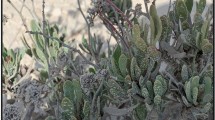Abstract
A disease ofMelaleuca armilaris (Myrtaceae) plants, belonging to the yellows group of diseases, is described from Israel. The disease was associated with bacteria-like organisms (BLO) occurring in growing tips. The BLO were observed in both xylem and phloem tissues. Electron microscope observations demonstrated that the overall number of cells invaded by BLO in winter, when seen best, was relatively small. BLO diameter was 400 to 650 nm and length was 950 to 1400 nm.
Similar content being viewed by others
References
Behncken, G.M. and Gowanlock, D.H. (1976) Association of a bacterium-like organism with rugose leaf curl disease of clovers.Aust. J. Biol. Sci. 29: 137–146.
Costerton, J.W. (1970) The structure and function of the cell envelope of Gram-negative bacteria.Rev. Can. Biol. 29: 299–316.
Glauert, A.M. and Thornley, M.J. (1969) The topography of the bacterial cell wall.A. Rev. Microbiol. 23: 159–198.
Grant, M.A. and Holt, J.G. (1977) Medium for the selective isolation of members of the genusPseudomonas from natural habitats.Appl. Environ. Microbiol. 35: 1222–1224.
Hopkins, D.L. (1977) Diseases caused by leafhopper-borne rickettsia-like bacteria.A. Rev. Phytopathol. 17: 277–294.
Irvin, R.T., Chatterjee, A.K., Sanderson, K.E. and Costerton, J.W. (1975) Comparison of the cell envelope structure of a lypopolysaccharide-defective (heptose-deficient) strain, and smooth strain ofSalmonella typhimurium.J. Bacteriol. 124: 930–941.
Kitajima, E.W., Bakarcic, M. and Fernandez-Valiela, M.V. (1975) Association of rickettsia-like bacteria with plum leaf scald disease.Phytopathology 65: 476–479.
Klein, M., Zimmerman-Gries, S. and Sneh, B. (1976) Association of bacteria-like organisms with a new potato disease.Phytopathology 66: 564–569.
Maramorosch, K. (1974) Mycoplasma and rickettsiae in relation to plant diseases.A Rev. Microbiol. 28: 301–324.
Mircetich, S.M., Lowe, S.K., Moller, W.J. and Nyland, G. (1976) Etiology of an almond leaf scorch disease and transmission of the causal agent.Phytopathology 66: 17–24.
Worley, J.F. and Gillespie, A.G. {jrJr.} (1975) Electron microscopyin situ of the bacterium associated with ratoon stunting disease in sudangrass.Phytopathology 65: 287–295.
Author information
Authors and Affiliations
Rights and permissions
About this article
Cite this article
Klein, M., Dabush, S. & Bar-joseph, M. A preliminary report on the occurrence of bacteria-like organisms in both phloem and xylem tissues of stuntedMelaleuca armilaris plants. Phytoparasitica 7, 169–175 (1979). https://doi.org/10.1007/BF02981123
Received:
Issue Date:
DOI: https://doi.org/10.1007/BF02981123




